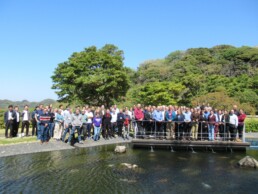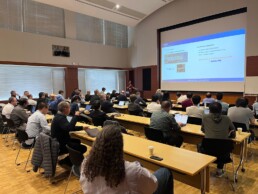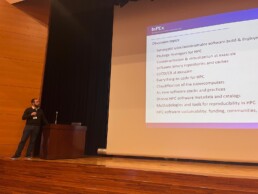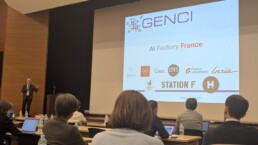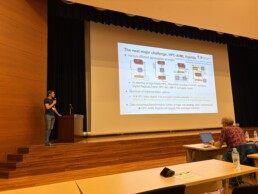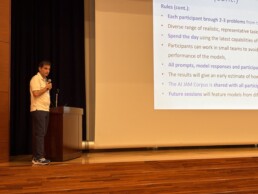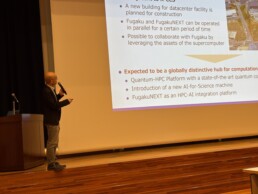
Workshop
2025 InPEx Workshop
April 15-17, 2025 – Kanagawa (Japan)
Workshop Presentation
Following the previous first InPEx meeting, the InPEx workshop held in Reims (France) in 2023 and the InPEx 2024 workshop held in Sitges (Spain), the InPEx community will meet in April 2025 in Japan. The workshop will gather around 100 experts in the HPC fields from Japan, the European Union and the United States.
Workshop topics
The 2025 InPEx workshop builds on the results of the InPEx working groups and will address important topics of the current development of the Post-Exascale era:
-
- AI and HPC: sharing AI-centric benchmarks of hybrid workflows
- AI and HPC: generative AI for Science
- Software Integration
- Digital continuum and data management
Date and place
The workshop will start at 9am on Tuesday 15th of April and will and at 1pm on Thursday 17th of April.
The workshop will be held in Japan at the Rofos Shonan – 1560-44 Kamiyamaguchi, Hayama-machi, Miura-gun, Kanagawa 240-0197.
A detailed agenda of the event can be read below.
Practical information for participants
Practical information concerning the organisation of the InPEx 2025 workshop can be found here.
Participants
Short bios of the workshop participants can be consulted here:
01_InPEx 2025 workshop_Participants Bio_V3
This workshop is hosted by the RIKEN Center for Computational Science (R-CSS), with the support of the French program NumPEx (Numeric for Exascale).
Agenda
08:45 - 09:00. Welcome
09:00 - 09:15. Introduction
Context and objectives of the meeting
- Jens DOMKE (Japan), Jean-Yves BERTHOU (Europe) and Pete BECKMAN (US)
09:15 - 11:15. Presentation and discussion on the InPEx working groups results and achievements since the Sitges (Spain) InPEx 2024 workshop
Chairman: Sergi GIRONA (BSC)
- Software production and management: packaging, documentation, builds, results, catalogs, continuous integration, containerization, LLVM, parallel tools and sustainability
- Julien BIGOT (CEA), Todd GAMBLIN (LLNL), Kento SATO (R-CCS)
- Co-design, benchmarks/mini-Apps/Proxy and evaluation (HW & SW & Applications)
- Jean-Pierre VILOTTE (CNRS)
- Digital Continuum and Data management
- Gabriel ANTONIU (INRIA), Manish PARASHAR (University of Utah), Kentaro SANO (R-CCS)
- AI for HPC and HPC for AI (ML, LLM for science, open models and datasets for AI training)
- Pete Beckman (Northwestern University), Thomas MOREAU (INRIA), Mohamed WAHIB (R-CCS)
- AI for HPC and HPC for AI: Unifying framework to enable Artificial Intelligence in HPC workflows
- Jens DOMKE (R-CSS)
11:15 - 11:45. Coffee break
11:15 - 12:45. Regional strategies around convergence of HPC and AI – General roadmaps and projects
USA
Chairman: Pete BECKMAN (NorthWestern University)
- 1000 Scientist AI Jam: DOE Labs experience exploring large AI models for science (Franck CAPELLO - ANL)
- NSF plans and roadmaps for HPC (John TOWNS - NCSA)
- The National Artificial Intelligence Research Resource - NAIRR (Manish PARASHAR - University of Utah)
- Perspective and overview of DoE and NSF HPC roadmaps (Brian VAN ESSEN)
12:45 - 14:00. Group Photo and Lunch
14:00 - 15:00. Regional strategies around convergence of HPC and AI – General roadmaps and projects
Japan
Chairman: Mohamed WAHIB (RIKEN-CSS)
Speaker: Masaaki KONDO (RIKEN-CCS), Kento SATO (RIKEN-CCS), Miwako TSUJI (RIKEN-CCS)
- Regional strategies around convergence of HPC, AI, and Quantum - General roadmaps and projects in Japan
15:00 - 16:00. Regional strategies around convergence of HPC and AI – General roadmaps and projects
Europe
Chairman: Jean-Yves BERTHOU (INRIA)
- AI Factory - General roadmap. European Commission DG Cnect - Juan PELEGRIN
- European AI Factories:
- Finland (Kimmo KOSKI (CSC)
-
- France (Jean-Yves BERTHOU (INRIA/GENCI))
-
- Germany (Bernd MOHR (JSC))
-
- Spain (Sergi GIRONA (BSC))
16:00 - 16:30. Coffee break
16:30 - 18:30. Subgroup session A1
Each subgroup is divided in two for 120 minutes
- AI and HPC : sharing AI-centric benchmarks of hybrid workflows
- Co-leaders: Franck CAPELLO (ANL), Jean-Pierre VILOTTE (CNRS), Mohamed WAHIB (R-CSS),
- Co-leaders: Franck CAPELLO (ANL), Jean-Pierre VILOTTE (CNRS), Mohamed WAHIB (R-CSS),
- Software production and management
- Co-leaders: Julien BIGOT (CEA), Todd GAMBLIN (LLNL), Kento SATO (R-CCS)
Introduction - Julien BIGOT
Virtual Fugaku bridging supercomputers and clouds - Kento SATO
Spack: the road to 1.0 - Todd GAMBLIN
Recap - Julien BIGOT
18:30 - 20:30. Reception and dinner
08:30 - 09:00. Welcome
09:00 - 11:00. Subgroup session A2
Each subgroup is divided in two for 120 minutes
- AI and HPC : Generative AI for Science
- Co-leaders: Pete BECKMAN (Northwestern University), Alfredo BUTTARI (IRIT), Thomas MOREAU (INRIA), Mohamed WAHIB (R-CSS)
- Digital Continuum and Data management
- Co-leaders: Gabriel ANTONIU (INRIA), Manish PARASHAR (University of Utah) , Kentaro SANO (R-CCS)
Feedback from Session 1
HEP use cases for HPC - Maria GIRONE and Tommaso BOCCALI
ESIWACE - Mario ACOSTA and Miguel CASTRILLO
ODISSEE - Damien GRATADOUR
Urgent Computing - Manish PARASHAR and Daniel BALOUEK
SKA - Mathis CERTENAIS
11:00 - 11:30. Coffee break
11:30 - 12:30. First wrap-up
Presentation of subgroups A1 and A2 wrap-up and discussion
Chairman: Mohamed WAHIB (R-CSS)
- 15 minutes per subgroup
12:30 - 14:00. Lunch
14:00 - 16:00. Subgroup session B1
Each subgroup is divided in two for 120 minutes
- AI and HPC : sharing AI-centric benchmarks of hybrid workflows
- Chair: Jean-Pierre VILOTTE (CNRS), Mohamed WAHIB (R-CSS), Franck CAPELLO (ANL)
- Software production and management
- Julien BIGOT (CEA), Todd GAMBLIN (LLNL), Kento SATO (R-CCS)
System Software Development for FugakuNEXT - Kento SATO (R-CCS)
16:00 - 16:30. Coffee break
16:30 - 18:00. Subgroup session B2
Each subgroup is divided in two for 120 minutes
- AI and HPC : Generative AI for Science
- Pete BECKMAN (Northwestern University), Alfredo BUTTARI (IRIT), Thomas MOREAU (INRIA), Mohamed WAHIB (R-CSS)
- Digital Continuum and Data management
- Gabriel ANTONIU (INRIA), Manish PARASHAR (University of Utah) , Kentaro SANO (R-CCS)
18:00 - 20:00. Reception and dinner
08:30 - 09:00. Welcome
09:00 - 10:30. Presentation of subgroups B1 and B2 wrap-up and discussion
(30 minutes per subgroup: 15 minutes of presentation/15 minutes of open discussion)
Chairman: Jean-Yves BERTHOU (INRIA)
- AI and HPC : Sharing AI-centric benchmarks of hybrid workflows
- AI and HPC: Generative AI for Science
- Software production and management
10:30 - 11:00. Coffee break
10:30 - 11:00. Presentation of subgroups B1 and B2 wrap-up and discussion
(30 minutes per subgroup: 15 minutes of presentation/15 minutes of open discussion)
Chairman: Pete BECKMAN (NorthWestern University)
- Digital Continuum and Data management
11:00 - 11:20. Next steps of the InPEx initiatives
Chairman: Pete BECKMAN (NorthWestern University), Jean-Yves BERTHOU (INRIA), Mohamed WAHIB (R-CSS)
- Future regional InPEx-related projects
- Building the next European strategy 2027-2034 (Jean-Yves BERTHOU)
-
- Japan (TBD)
- USA (TBD)
- Preparation of the next InPEx workshop
11:20 - 11:30. Conclusion of the workshop
Chairman: Pete BECKMAN (NorthWestern University), Jean-Yves BERTHOU (INRIA), Mohamed WAHIB (R-CSS)
12:00 - 13:00. Lunch
Presentation of the topics
Plenary sessions: regional strategies around the convergence of HPC and IA
The session will provide a broad overview of the three regional strategies and roadmaps towards the convergence of HPC and AI.
USA
- 1000 scientists AI Jam: DoE experience exploring large AI models for science (Franck CAPELLO)
- NSF plans and roadmaps for HPC (Dan STANZIONE)
- The National Artificial Intelligence Research Resource – NAIRR (Manish PARASHAR)
- Perspective and overview of DoE HPC roadmaps (To be confirmed)
Japan
Masaaki KONDO (RIKEN-CCS)
- AI for Science, Japan perspectives
- Advanced General Intelligence for Science Program (AGIS)
Europe
- AI Factory, General roadmap – EU DG CNECT – Grazyna PIECEWICZ or Juan PELEGRIN
- European AI Factories (Finland, France, Germany, Spain) – Kimmo KOSKI (CSC), Jean-Yves BERTHOU (INRIA), Bernd MOHR (JSC), Sergi GIRONA (BSC)
Parallel sessions
Digital Continuum
Session overview – Use cases
This session aims to present regional and international use cases of interest to explore expectations, design and effective implementation of digital continuum components.
Among the use cases:
- The Square Kilometer Array (SKA) is a workflow-intensive project that would benefit significantly from operating across multiple infrastructures. Documentation is available for this use case
Session overview – Continuum Digital Twin (CDT)
In addition to the use-case, the session will explore the concept of a “Continuum Digital Twin.” (CDT) This digital twin could abstract real systems to support cross-facility workflows without requiring direct interaction with physical infrastructure. By sharing only essential information needed for orchestration, the digital twin safeguards sensitive aspects of the real infrastructure. Real-time data flows from the infrastructure to the digital twin, ensuring an efficient and secure data exchange. A similar idea has been developed in the paper “Digital Twin Continuum: a Key Enabler for Pervasive Cyber-Physical Environments”.
In particular, this session will explore the idea of using the CDT concept for optimizing infrastructure (compute + storage + network) allocation and usage, especially from a sustainability point of view.
See Workflows Community Summit 2024, Future Trends and Challenges in Scientific Workflows – https://arxiv.org/abs/2410.14943
Software Integration
Session overview
Exascale and Post-Exascale applications are becoming increasingly difficult to build, deploy and maintain under the double pressure of the growing machine complexity and the applications’ needs to combine multiple compute and data processing paradigms (HPC, HPDA & AI). To address these challenges, our community needs to foster HPC dev-ops methodologies and tools to enhance productivity and improve interoperability, functionality and performance portability, as well as reproducibility
Session objectives
Topics of discussion cover all HPC dev-ops related subjects, including (but are not limited to):
- Synergetic user/administrator software build & deployment for HPC
- Package managers for HPC
- Containerization & virtualization at exascale
- Software binary repositories and caches
- CI/CD/CB at exascale
- Everything-as-code for HPC
- Cloudification of the supercomputers
- AI: new software stacks and practices
- Shared HPC software metadata and catalogs (softwareheritage.org)
- Methodologies and tools for reproducibility in HPC
- HPC software sustainability: funding, communities, foundations, …
AI and HPC: sharing AI-centric benchmarks of hybrid workflows
Session overview
In this session, we want to explore the increasing importance of rapidly evolving AI-driven and AI-coupled HPC/HPDA workflows in computational science and engineering applications.
These workflows typically involve the concurrent, real-time coupled execution of AI and HPC/HPDA tasks in ways that allow the AI systems to steer or inform the HPC/HPDA tasks and vice versa.
Enhancing the entire computing chain—from AI methods to workflow implementation and orchestration—requires the development of common collaborative benchmarks to allow fast progress and evaluation.
The shared benchmark approach has typically demonstrated its usefulness in deep learning with ImageNet or the BLUE benchmark, which allowed the identification of critical technology like ConvNets or Transformers and stirred the international community toward relevant research directions.
Adapting this methodology to drive progress in the integration of AI into HPC/HPDA software and application developments would allow overcoming traditional limitations and lead to significant effective performance enhancement — measured by science discovery for a given amount of computing — on different computing architectures while also testing various capability and capacity metrics such as accuracy and scalability.
These benchmarks should be based on shared insights from different coupling modes for AI and HPC/HPDA workflows and on the identification of execution motifs most commonly found in scientific applications with well-defined data and comparison metrics.
Adopting standardized practices and tools at the international level is essential for creating a consistent and collaborative framework and accelerating progress
Session objectives
- Propose/develop a common conceptual basis for understanding AI-driven HPC/HPDA workflows
- Identify and analyze different modes of coupling AI into HPC/HPDA workflows
- Identify execution motifs most commonly found in scientific applications, allowing to analyze the primary performance challenges underpinning AI-driven HPC/HPDA workflows
- Define shared and collaborative proxy-apps and benchmark exercises
- Develop standardized and specific benchmarks, including data/simulators and validation metrics,
- Address different modes of coupling AI into HPC/HPDA workflows
- Address coexistence and communication between HPC and AI tasks in the same workflow
- Plan a Development Timeline with Scheduled Meetings
- Create a roadmap with scheduled meetings (e.g., ISC25, SC25, InPEx26) to ensure timely progress and collaboration
Example use-cases may include:
- AI-Based Image Reconstruction pipelines
- In-situ AI-driven adaptive HPC simulations
- AI-based steering ensemble of simulations
- AI-based multi-stage HPC/HPDA pipelines
- AI-based robust inference methods
Adaptive execution for training large AI models
AI and HPC: Generative AI for Science
Session overview
This session will explore the transformative role of Generative AI in scientific research. Key themes include AI-powered hypothesis generation, data augmentation and simulation, and scientific writing and communication with LLMs. Discussions will explore synthetic data generation, discuss models like AlphaFold, GNoME, and FourCastNet, reproducibility and reliability, etc.
Practical information for participants
Download the latest version of the practical information.
Transportation
Coming to the Zushi-Hayama train station
From Narita and Haneda airports, as well as from Tokyo and other places, the most practical way to reach the Zushi-Hayama train station is the Keikyu Line (direct train)
From the Zushi-Hayama train station to the Rofos Shonan
Buses and taxis are available. Buses lines are n°16 or n°26

